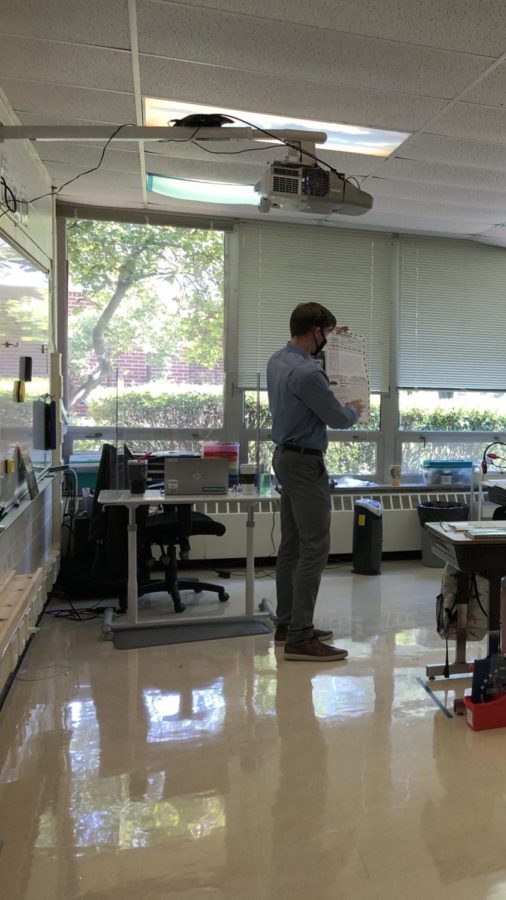Iowa State students navigate socially distant student teaching in-person and online
August 24, 2020
One facet of the Educator Preparation Program in the School of Education is helping students gain experience in a classroom setting.
While some schools throughout the nation are foregoing student teaching this fall, none of Iowa State’s partnered districts that are hosting student teachers have canceled any placements, according to Heidi Doellinger, director of the Educator Preparation Program.
Student teaching will nonetheless occur under supervisor and cooperating teacher observation. A supervisor is an independent person who goes into the classroom and observes the student teacher, while the cooperating teacher is the original classroom teacher who helps mentor the student teacher.
“Our [students] do whatever their cooperating teacher is doing in terms of the delivery model and method of instruction,” Doellinger said. “So if the cooperating teacher is teaching in-person face-to-face, then our student teacher will be teaching in-person face-to-face…The experience will be the same in any [teaching method] in regards to [students] phasing their way in to take on more and more responsibilities, planning and receiving coaching from both the cooperating teacher and a supervisor. Those experiences will remain the same, they will just, for some of our [students], look a little bit different than perhaps they had anticipated when they began the [Educator Preparation Program].”
Joshua Poterack, senior in elementary education, was placed in a fifth grade classroom in St. Charles, Illinois. His school started teaching online classes last week while a classroom of third graders went into the school and tested out their in-person model of teaching.
“I think for the time being, unless this lasts for a really long time, I don’t think it’s super harmful,” Poterack said. “But I definitely think it’s hard to learn online. With fifth graders, it’s a little bit easier, but as you get younger and younger, you can’t do as much individual, one-on-one help. It’s all just going to be hard.”
His fifth grade class went into the classroom for half a day Friday to go over the new safety measures and expectations for the classroom. His class goes to in-person learning this week with desks marked six feet apart, mask requirements and self-checks for illness. All of the water fountains are also turned off except for the refillable water bottle sensor.
Only two kids are allowed in a bathroom at once with spots for social distancing in the hallway and around the building. They also have “outside classrooms,” which are spots marked outside where students have a chance to remove their masks while staying socially distant.
During recess, kids are required to stay six feet apart, and they will not be able to use playground equipment. Poterack is trying to get creative with games for students that follow the guidelines set by his school.
“My cooperating teacher is pregnant, and I was curious how she felt about [in-person teaching],” Poterack said. “She seems pretty comfortable being in-person. The school has actually done a pretty good job and the district, which has eased everyone’s stress a little bit. I’m happy I get to be in-person, but we’re all kind of thinking we may have to eventually go online.”
His district also has full-time trained substitute teachers, so if anything goes wrong they can step into a class when needed. He said that his cooperating teacher was very upfront about him being part of their classroom, giving him a chance to utilize his lessons and taking charge of the class, which has given him more valuable experience in his field.
Mackenzie Klima, senior in elementary education, was placed in an ESL elementary classroom in Aldine, Texas. Her school decided to teach all online classes, but Klima said she was able to bring her technological knowledge to the table to help her cooperating teacher. She started class last week.
She said her school will be flexible with attendance the first couple weeks of class, as some students are waiting on a password request from the district office. She said that by the end of the week, only one student was absent.
Her school is providing laptops and Wi-Fi hotspots for those students who need it. Some of her kids are able to work from home, but some are working from their parents’ offices as well. Klima is teaching from her classroom with her cooperating teacher, meaning she wears a mask while she teaches online.
“My students’ first language is Spanish, and I teach them in English,” Klima said. “A difficult part is teaching phonics, which is sounding out letters, while wearing my mask. They can’t see the way my mouth moves to create the sound […] When we are on video calls, it’s hard to hear who is pronouncing right and who isn’t, because it’s a mess when everyone has their microphones on at once.”
Klima went on to say that not being able to give individual attention to students has been challenging.
“When you have a full class of kids where most students understand a concept and maybe four don’t, we have to set up a separate meeting to go over the concept again, or I end up reteaching it to a whole class,” she said.
Klima said she is thankful for everyone who has put in the hard work to make classes possible.

















